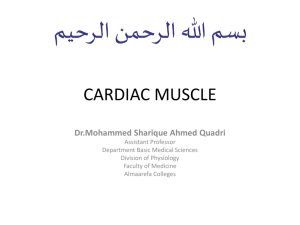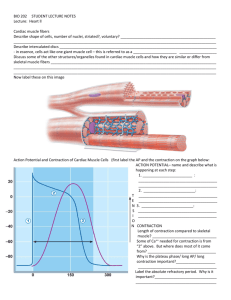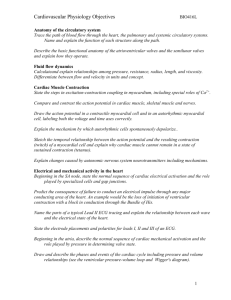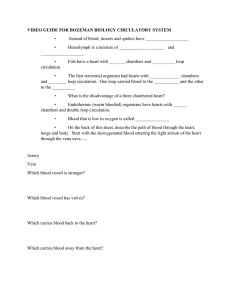L5MSK (2)
advertisement
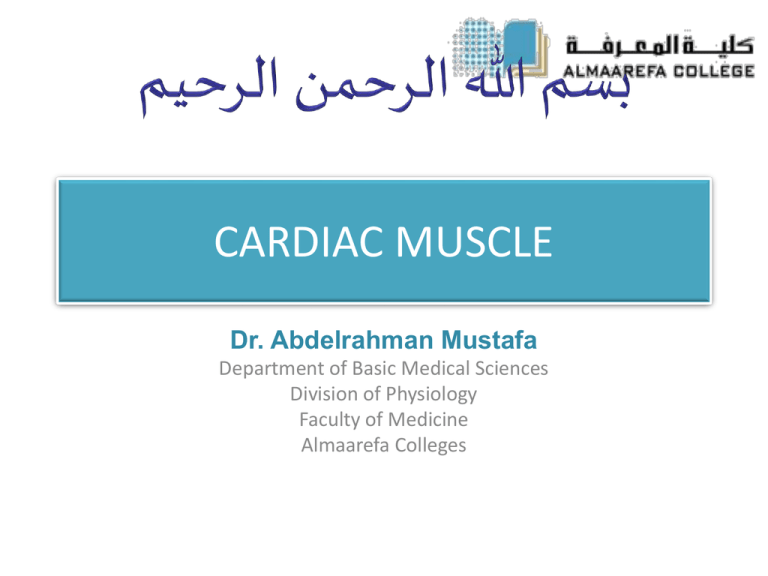
CARDIAC MUSCLE Dr. Abdelrahman Mustafa Department of Basic Medical Sciences Division of Physiology Faculty of Medicine Almaarefa Colleges Learning Objectives • • • • • • • • • • • By the end of this lecture you should be able to Identify the types of cardiac muscle cells Define the cardiac muscle Autorhythmicity Describe the pace maker potential Define the cardiac muscle excitability Describe the Ventricular potential Define the cardiac muscle contractility Describe the mechanism of cardiac muscle contraction Define cardiac muscle conductivity Identify the conductive system of the heart Describe the starling law of the heart CARDIAC MUSCLE 3Layers: • Epicardium, • Endocardium • Myocardium , 4 Chambers • Rt atrium • Rt Ventricle • Lt atrium • Lt ventricle 4 large vessels • Aorta • Pulmonary artery • Vena Cava • Pulmonary veins 4 Valves • Tricuspid • Mitral • Aortic • Pulmonary Types of Cardiac Muscle Cells • Contractile Cells – 99% of Cardiac Muscle – Do mechanical work of contraction – Do not generate action Potential in normal conditions (Can generate Action Potential in abnormal conditions) • Autorhythmic cells: – Initiate Action Potential – Conduct Action Potential • Do not contract • Interconnected by intercalated discs and form functional syncytia • Within intercalated discs – two kinds of membrane junctions – Desmosomes – Gap junctions Cardiac Muscles Action=Action of Pump 5 What are the Properties that allowed the Cardiac Muscles to Act as PUMP? 6 AUTORHYTHMICITY • Definition Is the ability of cardiac muscle to contract in self regular constant manner • IS IT MYOGENIC OR NEUROGENIC IN ORIGIN ? • MYOGENIC This is evident by :• 1)The frogs apex beating • After deinnrevetion in Ringr Lactate soulation • 2)The embryo heart started to beat BEFORE CNS DEVELOPMENT AUTORHYTHMICITY • Cardiac autorhythmic structure that initiate AutoRhythmicity Called PACE MAKER spontaneous depolarization to threshold is known as PACE MAKER POTENTIAL 8 AUTORHYTHMICITY( PACE MAKER POTENTIAL) PHASES OF PACEMAKER POTENTIAL Prepotential Causes : Na+ going inside(Infflux ) Ca++ going inside(Infflux ) ↓ K+ going outside(Efflux) After Prepotential we get Depolarization and Repolarization Depolarization Cause: Ca++ going inside(Infflux ) Repolarization Cause : K+ going outside(Efflux) EXCITABILITY Definition is the ability to respond to stimuli by generation action potential. The resting membrane potential of the contractile fibers is stable at about– 90 mV. • Once myocardial cells are stimulated by action potential originating in PACEMAKER , it produces its own action potential Action Potential of ventricular muscle fiber has four phases 0, 1, 2, 3 ,4. Excitability (Myocardial Action 0 = Rapid Depolarization Potential ) + (inward Na current) 1 1= Early partial repolarization 2 = Plateau (inward Ca++ current) 2 0 0 3 PHASE 3 = Repolarization (outward K+ current) 4 = Resting Potential 4 -90 TIME EXCITABILITY • The heart passes through two phases of excitability :1)The absolute refractory period 2)The relative refractory period • Because long refractory period occurs in conjunction with prolonged plateau phase, – Ensures alternate periods of contraction and relaxation which are essential for pumping blood CONTRACTILITY • Definition The ability of cardiac muscle to convert chemical energy to mechanical work • Ca2+ entry through L-type channels in T tubules triggers larger release of Ca2+ from sarcoplasmic reticulum – Ca2+ induced Ca2+ release leads to cross-bridge cycling and contraction – 90% of Ca2+ needed for contraction comes from sarcoplasmic reticulum Excitation-Contraction Coupling in Cardiac Contractile Cells CONDUCTIVITY • Defienion Is the ability of cardiac muscle fiber to conduct cardiac impulses that are initiated in SA node, which is the pacemaker of the heart 1. Sinoatrial (SA) node The conductive system 2. Atrioventricular (AV) node 3. Atrioventricular bundle (bundle of His) 4. Bundle branches 5. Purkinje fibers Cardiac Muscle Mechanics Starling’s law of the heart :• Law states that : with in physiological limit , the force of myocardial contraction is directly proportional to the initial length of the cardiac muscle fibers 10 MINs for study Q1 • The cells that responsible to convert the chemical energy to mechanical work called • A)Contractile Cells • B)Autorhythmic cells: • C)Conductive cells • D)Desmosomes Q2 • • • • • Pacemaker depolarization caused by : A)Na+ Infflux B)Ca++ Infflux C)K+ Efflux D)Ca++ Efflux Q3 • the ability to respond to stimuli by generation action potential known as : • A)cardiac muscle Auto rhythmicity • B)cardiac muscle excitability • C)cardiac muscle contractility • D)cardiac muscle conductivity Q4 • Starling’s law of the heart Describe the relationship between : • A) Contraction and cardiac muscle Length • B) Contraction and cardiac muscle conductivity • C) Contraction and cardiac muscle excitability • D) Contraction and cardiac muscle Auto rhythmicity References • Human physiology by Lauralee Sherwood, 7th edition • Text book physiology by Guyton &Hall,12th edition • Text book of physiology by Linda .s contanzo,third edition 22

